Jump to:
You’ve heard the term, but what exactly is a hair salon? You’ll be surprised to find out that it’s much more than just stylists offering haircuts. Read on to learn all about salons in our complete guide below.
What Exactly Is a Hair Salon?
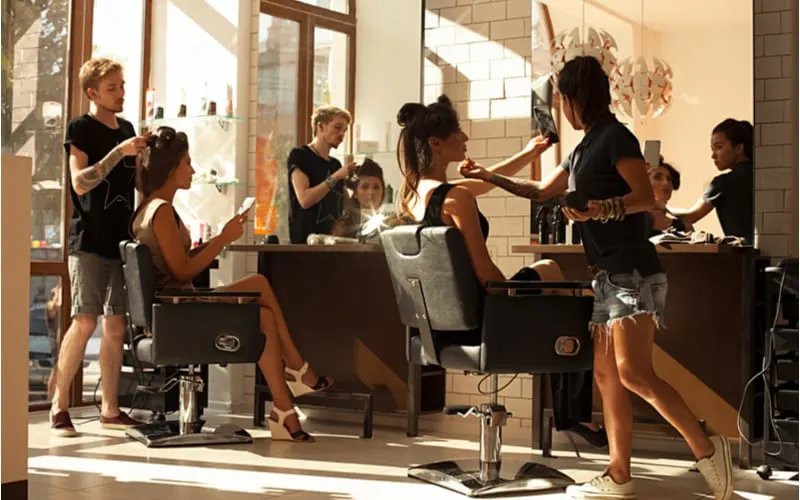
Karashaev/Shutterstock
A hair salon is a business that offers hair styling and other cosmetic services. Usually, a hair salon will have a team of hair stylists to provide these services.
The hair stylists are required to be licensed cosmetologists trained as either hair stylists, general cosmetologists, estheticians, barbers, or manicurists.
Stylists will either be employed by the salon directly or rent their own booth space to provide services to clients.
In a salon, you can expect a few standard services to be available, like hair cutting, coloring, highlighting, and styling. Hair and scalp treatments are usually available as well.
Some salons offer additional services that extend beyond hair, like massage, makeup, tanning, nail care, skincare, and waxing.
Learn about types of hair salons, walk-ins vs. appointments, hair salon staff, salon services, and average prices in our complete guide.
Types of Hair Salons
There are a few types of salons you might find in your area. Not all hair salons offer the same kinds of services. Here are the general types of salons and what you can expect each one to offer to clients.
Hair Salon
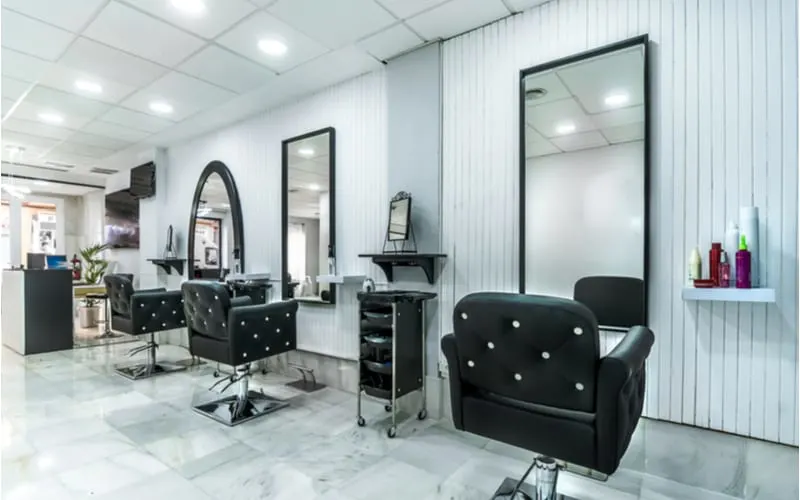
elRoce/Shutterstock
A hair salon is a business that offers a range of hair-related services to clients. This includes haircutting, regular and formal styling, chemical treatments (such as color, highlights, perms, and straightening treatments), hair and scalp treatments, and beard and mustache shaping.
In a true hair salon, other cosmetic services may not be offered. There are two general types of hair salons: Franchise and independent.
Franchise Hair Salons
Franchise hair salons are part of a chain of salons that may extend regionally or nationwide. Franchise owners pay a fee to open a salon under the chain’s name. Examples of franchise hair salons are Great Clips, Sport Clips, and Supercuts.
These franchise salons are built and managed based on uniform brand standards. So if you visit a Great Clips location in Omaha, it will be nearly identical to one in Nashville.
Typically, franchise hair salons employ salaried hair stylists who may be paid an additional commission for high productivity or selling hair products. Franchise hair salons usually accept walk-in customers rather than requiring appointments.
Many people like franchise hair salons because they can get a consistent experience each time they visit, pay less for the services, and go in for a haircut whenever is convenient for them.
Independent Hair Salons

Roman Samborskyi/Shutterstock
Independent hair salons are owned by individuals and are not part of a regional or nationwide franchise. The owner/operator(s) of an independent hair salon chooses the name, logo, services provided, and pricing for services.
They hire hair stylists and other cosmetologists on a salary, salary plus commission, commission only, or booth rental payment basis.
Independent hair salons may specialize or have stylists who specialize in a specific service (such as color or highlights) or offer a general menu of hair services.
They may or may not sell hair products in addition to offering services. You’ll find independent salons that accept walk-ins and others that operate by appointment only.
Many people like independent hair salons because stylists in them are given more creative freedoms than in franchise salons. Visiting an independent hair salon is also supporting a local small business.
These salons are also more likely to have established, higher-end stylists working in them. On the other hand, you may pay more for services at an independent hair salon, and your experience may not be as consistent without brand and management rules in place.
Beauty Salon
A beauty salon is a hair salon that also offers additional cosmetic and beauty-related services. In addition to haircuts, colors, and styling, beauty salons may offer waxing, makeup artistry, tanning, and nail services.
When you visit a beauty salon, you can get various services done in the same place rather than visiting a separate manicurist, makeup artist, or tanning salon.
Beauty salons may employ licensed general cosmetologists, hair stylists, manicurists, estheticians, and barbers to provide services. Generally, most beauty salons accept appointments and walk-ins when possible with an open walk-in policy.
This means if any stylist, manicurist, or esthetician is not busy with an appointment when a walk-in arrives, they will accept the walk-in.
Beauty salons choose which services to offer and base those services off the cosmetologists or barbers who work there. To find out exactly what’s available, you’ll need to check with each salon.
Barber Shop
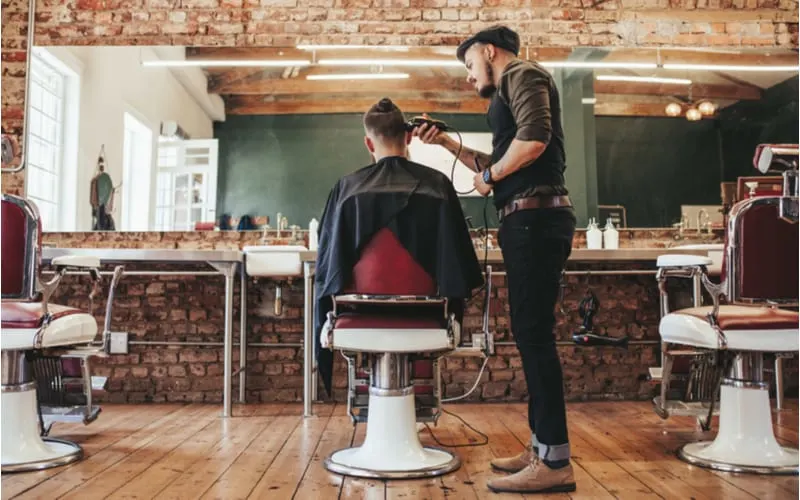
Jacob Lund/Shutterstock
A barber shop is similar to a hair salon, but it caters primarily to men and boys. Barbers, who have different licensing than cosmetologists, groom, style, color, cut, and shave men and boys’ hair.
They also groom, cut, shave, or style mustaches and beards. Some barber shops specialize in custom shaved designs, straight-razor shaves, ethnic hair, or recreating the old-school barber shop atmosphere.
Licensing laws for barbers vary by state. For example, in Pennsylvania and Maryland, only barbers are licensed to use a straight razor for shaving. Cosmetologists cannot use a straight razor.
Although barber shops generally cater to men, it is not uncommon for men to visit a hair salon or beauty salon for services.
Salon and Spa
A salon and spa (sometimes called a full experience or full-service salon) is similar to a beauty salon, but offers additional pampering services beyond hair, nails, and waxing.
A salon and spa may have a licensed masseuse to provide massage services, a complete manicure/pedicure setup, tanning and spray tanning, and estheticians specializing in skincare, waxing, threading, makeup, and other services.
Some salon/spa businesses are also licensed to sell or offer alcoholic beverages to clients during their visit. Salon/spas are popular for a girls’ day out, bridal parties, special occasions, and general spa days.
They enable clients to get many beauty and wellness treatments done in one place without scheduling multiple appointments.
Generally, full-service salons will have a spa-themed atmosphere for clients’ relaxation and pampering during their visit. Services may be more expensive than in a hair salon or beauty salon.
Boutique or Specialty Salon
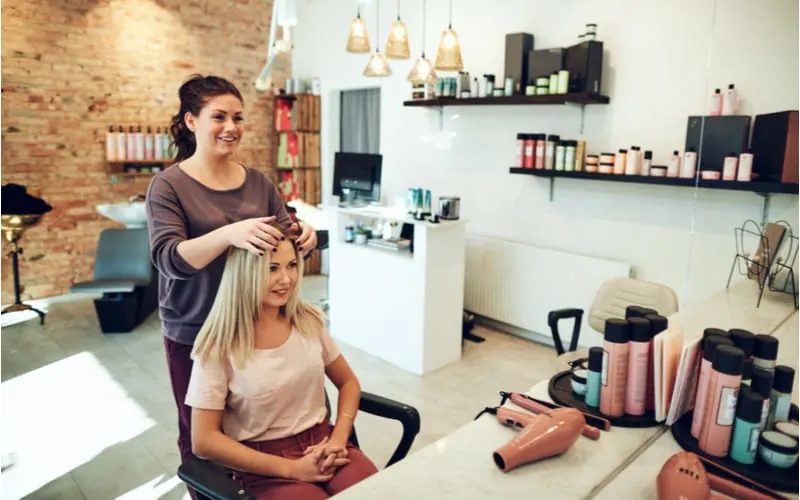
Flamingo Images/Shutterstock
A boutique or specialty salon typically specializes in a particular service or treatment. These salons are usually small and may have fewer stylists or cosmetologists working in them.
Boutique salons generally operate by appointment only and may offer special complimentary services for clients like hand massage during visits, snacks and beverages, or spa-like treatments.
Boutique salons differ from a salon and spa or full-service salon because they don’t usually provide a full menu of services. For example, one boutique salon may specialize in blonding (dying hair to a blond shade) and color correction.
This kind of salon would primarily accept appointments for those services only. Other boutique salons have a few stylists who each specialize in something different and can serve a wider client base.
The boutique salon atmosphere will depend on the owner/operator and what type of services are offered, but these salons are usually highly focused on design and decor.
Most boutique salons will be higher-end establishments. Clients can expect to pay more for services at a boutique salon.
How Salons Serve Clients
How do clients patronize a salon to receive hair or cosmetic services? Any of the above types of salons may accept walk-in clients or require clients to schedule an appointment in advance to receive services. Read more about each way salons serve clients below.
Walk-In Hair Salons
Salons that accept walk-in clients (usually referred to as “walk-ins”) may employ a team of salaried hair stylists that work scheduled hours.
Or, they may have a team of independent stylists who pay booth rent and will accept walk-ins when they have no regular appointments booked.
If a hair salon accepts walk-ins, clients that arrive within business hours will be serviced by one of the available stylists. If no stylists are available at the time, the walk-in client will have to wait in a designated waiting area or come back another time.
Pros
Salons that accept walk-ins are best for clients who want a routine service (such as a haircut) done in a timely fashion or don’t want to schedule an appointment.
They are also better for clients who don’t have a stylist preference. If you suddenly need a hair service done quickly (like before an unexpected event), a walk-in salon may be your only option.
Cons
One downside of going to a salon that accepts walk-ins is that you aren’t guaranteed a time slot and may not be able to get services the day you walk in. You may have to wait a while for a stylist to become available, and you may not get to choose the stylist who services you.
Appointment Only Hair Salons

Dasha Petrenko/Shutterstock
Appointment-only salons are usually salons with established hair stylists who have a regular clientele base. Stylists in appointment-only salons will book appointments with clients in advance rather than accepting walk-ins.
These appointments will be scheduled based on the amount of time the requested service should take. For example, a client booking an appointment for a cut and color requires a longer appointment than one requesting a trim.
Stylists who are appointment-only may set their hours according to the appointments they have booked or work in scheduled shifts.
Pros
Appointment-only salons are best for clients who have a stylist preference and know what services they might like to have done in advance. One benefit appointment-only salons offer is a scheduled time slot that is guaranteed to be available for the client.
With a scheduled appointment, your stylist will be able to prepare for your visit by ensuring they have the right colors, chemical solutions, and tools for your visit. You may have less waiting time than with a walk-in salon as well.
Cons
The downside of going to an appointment-only salon is that stylists may “book up” (with no available appointment slots) quickly, so you may have to set an appointment weeks in advance. If you need a service done unexpectedly or quickly, your stylist may not be able to squeeze you in when you want.
Hair Salon Staff
Hair salons of all types will employ licensed professionals and unlicensed staff members for administrative and support functions. When you visit a hair salon, you might see any of the following staff members working.
Hair Salon Manager

Stockshakir/Shutterstock
Salon managers are responsible for handling paperwork, billing, scheduling (if applicable), purchasing retail products to be sold in the salon, and record keeping.
Managers coordinate maintenance and cleaning and ensure all equipment and tools responsible for the salon are in working order. If a salon has salaried stylists, they will handle any interpersonal issues or scheduling problems.
Hair Stylists
Hair stylists are the center of the hair salon. These are state-licensed professionals that provide the hair-related services in a salon: Cuts, colors, highlights, styles, treatments, and more.
Some hair stylists are licensed as general cosmetologists and can give manicures, pedicures, facials, apply makeup, and more.
In a barber shop, the hair stylists are referred to as barbers. Depending on the state, their licensing may be slightly different from a cosmetologist’s.
Salon Assistant or Shampoo Assistant
Some salons employ salon or shampoo assistants to help stylists. These assistants are generally cosmetology students who are earning training hours to get their license.
They may also be newly-licensed cosmetologists who are gaining experience in the industry before becoming a stylist.
Salon assistants might shampoo a client’s hair, remove perm rods and rinse for a stylist, fold towels, sweep hair trimmings, or put clients under a dryer for a stylist when they’re working with another client.
Salon Receptionist

VGstockstudio/Shutterstock
A salon receptionist has a client-facing job. They are responsible for answering the phone, booking appointments for stylists and other licensed professionals in the salon, greeting customers, estimating wait times, directing walk-ins to available stylists, and taking customer payment.
Nail Technician
Some salons employ nail technicians who provide services like acrylic nail application, nail shaping, manicures, pedicures, and custom nail art.
Nail technicians can be licensed general cosmetologists or specialized licensed nail technicians. They may also be called manicurists or pedicurists.
Esthetician
A salon may have an esthetician on the team to provide services including waxing, basic massage, facials, spray tan application, makeup application, and skin care treatments.
You’ll see estheticians in salon/spa combinations and boutique salons more often. A cosmetologist also provides these services, but an esthetician is not licensed to perform hair-related services.
Massage Therapist
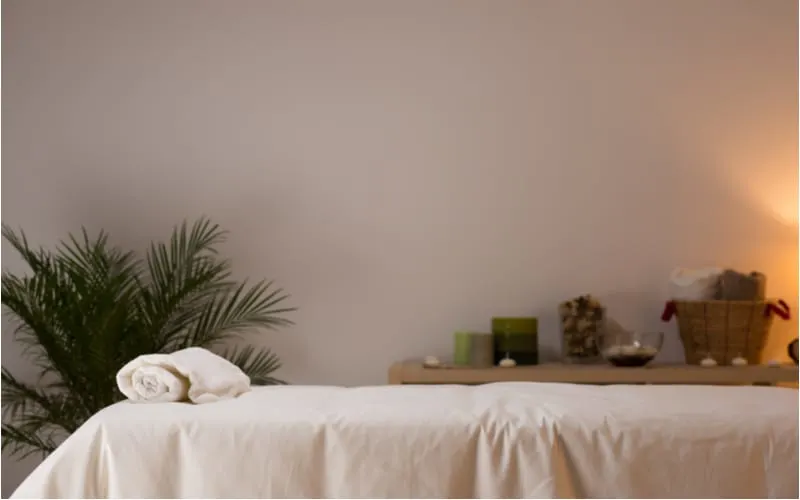
Milles Studio/Shutterstock
A salon may employ a massage therapist, especially if it is a full-service salon/spa or boutique salon. Massage therapists provide body massage and have more training than estheticians.
They usually have a dedicated room with a massage table for ultimate client comfort. States require massage therapists to be licensed.
Salon Services
Wondering what types of services a hair salon may provide? While every salon is different, many generally offer a similar menu of services. Here’s what you can expect a hair salon to offer for clients.
Hair Salon Services
- Haircuts and trims
- Haircutting with clippers
- Single-process color
- Double-process color
- Highlights (cap or foil)
- Straightening treatments
- Perms
- Relaxers
- Hair extensions
- Blowouts
- Braids
- Basic hairstyles
- Formal hairstyles
Beauty Salon Services
In addition to the services offered by hair salons, beauty salons may also offer these.
- Waxing
- Makeup application
- Tanning
- Spray tanning
- Manicures
- Pedicures
- Acrylic nail and tip application
Full-Service Salon Services
In addition to the services offered by hair salons and beauty salons, full-service salons may also offer these.
- Massage
- Facials
- Skincare consultation
- Lash extensions
- Electrolysis hair removal
- Fillers and injections
Barber Shop Services
Barber shops may offer the following types of services to clients.
- Haircuts and trims
- Haircuts with clippers
- Shaves
- Custom shave designs
- Braids
- Facial hair grooming, cutting, and styling
- Colors and highlights
- Basic hairstyles
- Basic manicures
- Waxing
How Much Does It Cost to Go to a Hair Salon?
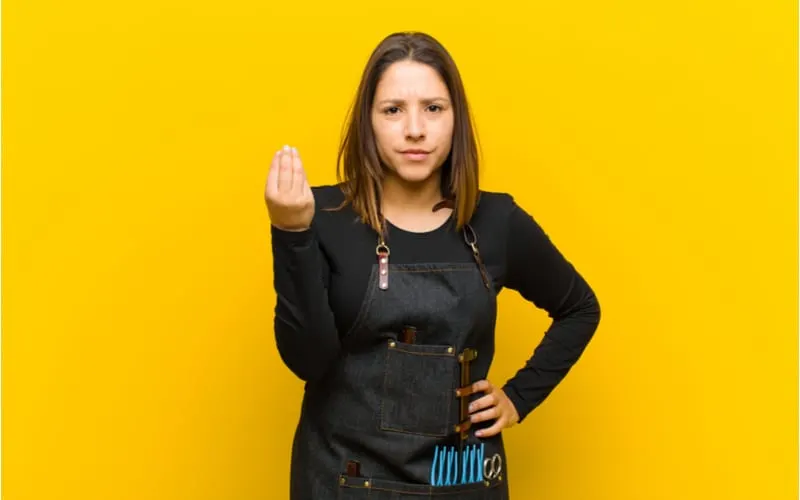
Kues/Shutterstock
Every hair salon has a different pricing model, but there are some averages for basic services. Check these nationwide averages out to get an idea of how much it costs to go to a hair salon.
Remember: These averages may be higher or lower than prices in your area.
If you have very long or thick hair, or if you’re having a complex process done (like multiple colors or a custom shaved design), prices will be higher.
| Service | Low End | High End |
|---|---|---|
| Haircut | $15 | $150+ |
| Children's haircut | $15 | $45+ |
| Trim | $10 | $15+ |
| Partial foil highlights | $100 | $150+ |
| Full foil highlights | $115 | $200+ |
| Balayage highlights | $155 | $300+ |
| Color | $65 | $200+ |
| Double process color | $135 | $175+ |
| Formal style | $35 | $200+ |
| Blowout | $30 | $50+ |
| Flat iron/Curling | $20 | $30+ |
| Chemical straightening | $300 | $350+ |
| Perm/Chemical wave | $30 | $150+ |
| Manicure | $30 | $40+ |
| Pedicure | $45 | $50+ |
| Waxing | $15 | $30+ |
So, What Is a Hair Salon?
The hair salon has been an integral part of society for centuries. Women, men, and children all visit hair salons to keep their hair groomed and ensure they look their best.
Depending on the type of hair salon you choose, you might be able to get your hair cut and styled, colored and highlighted, or chemically straightened or waved.
You can even get a pedicure, wax, and massage if you choose a full-service hair salon! It’s easy for a great hair salon to become your new “happy place.”
Whether you’re actively looking for a hair salon near you or just wanted to get an idea of what a hair salon is and services they offer, we hope this guide has been helpful!
Browse our site to find hair salons in your area and learn more about choosing a great salon.
